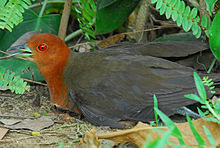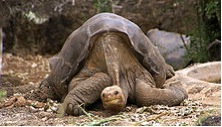Iriomote Cat – Living Fossils
Here is a great article on a seldom known animal called the Iriomote Cat. The article comes from one of our fans Carmen Guerrero from Arizona who has been working with Olivia and Carter for sometime now.
 The Iriomote Cat is a subspecies the Leopard Cat that lives only on the island of Iriomote, a little island off the coast of Japan. The species was first discovered in 1967. Although its relative, the Leopard Cat, is not on the endangered species list (yet), the Iriomote Cat is critically endangered; there being less than 200 in the wild making it one of the worlds rarest and most endangered species.
The Iriomote Cat is a subspecies the Leopard Cat that lives only on the island of Iriomote, a little island off the coast of Japan. The species was first discovered in 1967. Although its relative, the Leopard Cat, is not on the endangered species list (yet), the Iriomote Cat is critically endangered; there being less than 200 in the wild making it one of the worlds rarest and most endangered species.
They are small cats, most weighing between 7-9 pounds. They also have very short legs, making them look somewhat like Munchkins. These cats also retain some primitive features. It is estimated that their last shared ancestor with other cats lived about ten million years ago, making it one of the world’s oldest species. The Iriomote’s ancestors are believed to have crossed from Asia into the island of Iriomote some three million years ago.
Iriomote cats are important to the ecosystem of the island of Iriomote. As the only carnivores on the island, they have a huge role to play in keeping other animal populations in balance. They are solitary animals and range over a broad range of different areas, from sea level to the mountains. It is estimated that Iriomote cats live about 7 years in the wild and 9 in captivity. Although one cat named Yon lived up to 15 years in captivity.
in balance. They are solitary animals and range over a broad range of different areas, from sea level to the mountains. It is estimated that Iriomote cats live about 7 years in the wild and 9 in captivity. Although one cat named Yon lived up to 15 years in captivity.
Although Iriomotes are one of the world’s most studied cats, relatively little is known about its ecology, and people are trying to conserve them. In 1977, His Royal Highness Prince Phillip, Duke of Edinburg wrote to a letter to Prince Akihito addressing the issue of conservation of the Iriomote cats.
In the report he included in his letter, he suggested outlawing further migration to the island and banning land cultivation. Prince Akihito said he would like to conserve the cats, but he would like a way to conserve the cats and ensure continued human habitation of the island. It has also been suggested making a wildlife sanctuary for Iriomotes. Road signs have also 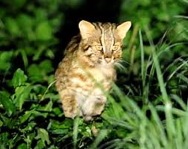 been put up warning people to keep an eye for Iriomotes crossing the road, as being run over by cars has also killed many. Other measures have been installing wide ditches on the side of the roads, and zones where cars make a lot of noise when passing over them to keep the cats away. However, many people have complained that these measures have caused a lot of inconvenience.
been put up warning people to keep an eye for Iriomotes crossing the road, as being run over by cars has also killed many. Other measures have been installing wide ditches on the side of the roads, and zones where cars make a lot of noise when passing over them to keep the cats away. However, many people have complained that these measures have caused a lot of inconvenience.
Since people came to the island, things have not gone too well. Apart from habitat loss, there is also predation by dogs, traffic accidents, and traps set for wild boars have also contributed to the decline in population. Only shortly after its discover, the Iriomote has been listed under ‘endangered’, and was listed under ‘critically endangered’ in 2008. In 1997, the Iriomote was given status as a national monument.
House pets have also presented a problem for the Iriomote. Dogs sometimes prey on Iriomotes, and house cats have presented competition
by hunting prey, which the Iriomotes feed on. As the Iriomotes have been the only predators on the island for millions of years, this has had an impact on the bird and small animal population, which in turn has an impact on the Iriomotes. Apart from competition, house cats also present transmit diseases such as FIV, and genetic pollution. A study was done to test several feral cats and Iriomotes for FIV. Although three feral cats tested positive, all the Iriomotes tested negative. It is now required for residents to register their cats and it is mandatory to test and vaccinate them against FIV as well as spaying or neutering.
Iriomotes have also become the town mascot in a picture, which was drawn by a sixth grader. They are well known cats on the island, being pictured on walls and even sides of buses.
Diet
Iriomote cats are carnivorous and prey on various mammals, birds, reptiles, amphibians, fish, and crustaceans. They typically ingest 400–600 grams of food a day. Other types of wild cats will primarily hunt small mammals such as rodents and rabbits, but because there are no other carnivores to compete with the Iriomote cat on the island, there is no need for them to isolate themselves from the various habitats and food sources that are available. Thus, their diet is quite varied. Slaty-legged crakes make up a portion of Iriomote cats’ diet
Mammals they eat include black rats, the Ryukyu flying fox, and young Ryukyu wild boar. Their prey also includes a wide range of birds such as the spot-billed duck, slaty-legged crake, Eurasian scops-owl, pale thrush, and white-breasted waterhen. Reptiles include various types of snakes and Kishinoue’s great skink.They are also known to eat Sakishima rice frogs, yellow-spotted crickets, and crabs. As their hunting grounds tend to be in swamps or on shores, they will sometimes swim and dive to catch water birds, fish, and freshwater prawns.
When eating birds that are larger than a dusky thrush, most types of cats will pluck the feathers and then eat it, but the Iriomote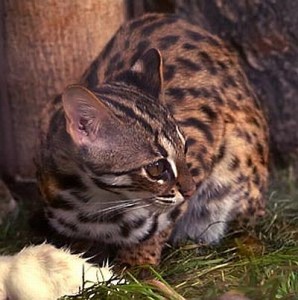 cat will eat even large birds whole without removing the feathers. Also unlike other cats, the Iriomote cat will not kill its prey immediately by breaking the spinal cord. Instead it will hold the animal in its mouth until it stops moving.
cat will eat even large birds whole without removing the feathers. Also unlike other cats, the Iriomote cat will not kill its prey immediately by breaking the spinal cord. Instead it will hold the animal in its mouth until it stops moving.
Based on stool samples, birds appear in the Iriomote cat’s diet about 60% of the time, black rats 30%, insects 30%, lizards and frogs about 15-20%, bats 3–17%, and boar less than 1% of the time. In addition, fish and crustaceans appear roughly 3–4% of the time. It is estimated that over a period of one year, water birds will comprise about 60% of the cat’s diet with black rats being its secondary source of food at about 10–30% per year. Seasonal dietary changes have been observed. They will eat rats and frogs year-round, lizards in the summer and spring, and crickets and bats more often in fall and winter
Although cats are very popular in Japan, the Iriomote is Japan’s only cat. The Iriomote is the rarest of all cats, and it would be a shame that Lonesome George’s successor of the title ‘Rarest Living Creature’ be an Iriomote, or any other individual for that matter. Lonesome George was known as the rarest living creature when he was alive because he was the only, which is a subspecies of Galapagos tortoise, on the planet. It was always a dream of mine to meet Lonesome George. Although, of course, no one was sure how old he was exactly, and I knew he was the last of his subspecies, I honestly never thought that I wouldn’t be able to meet him someday. With his death almost two months ago the Pinta Island tortoise became extinct. I think that should encourage people more to help conserve other species.
Is this the way we want to see Iriomote Cats?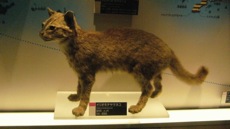
We wish to thank Carmen for sending us this great report and we encourage others to send us articles on whatever species interests you and we will gladly feature them on our website as well.
Thanks for caring from all of us at OMG 😉


